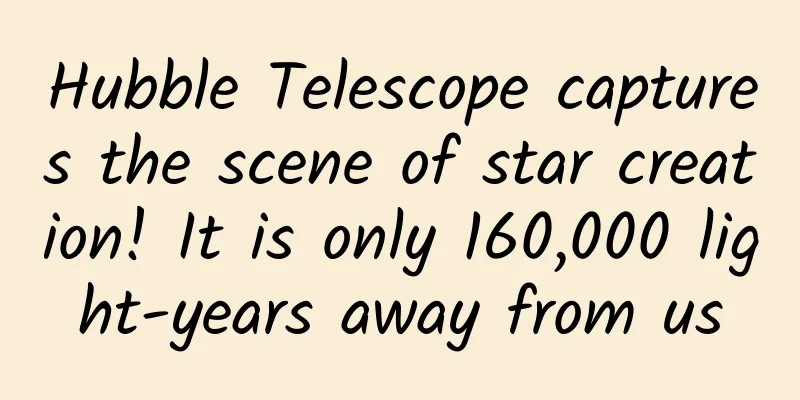Hubble Telescope captures the scene of star creation! It is only 160,000 light-years away from us

|
The Hubble Space Telescope captured this view of star creation, located near the outskirts of the famous Tarantula Nebula. This nebula of gas and dust, and the many young massive stars surrounding it, is a perfect laboratory to study the birth of massive stars. The bright pink nebula and the young stars surrounding it in this image taken by the NASA/ESA Hubble Space Telescope are named LHA 120-N150. This region of space is located on the outskirts of the Tarantula Nebula, one of the largest stellar nurseries known in the universe. The nebula is located more than 160,000 light-years away in the Large Magellanic Cloud, an irregular dwarf galaxy orbiting the Milky Way. The Large Magellanic Cloud has had one or more close encounters in the past, possibly with the Small Magellanic Cloud. These interactions have caused an episode of energetic star formation in our tiny neighbor, part of which can be seen as the Tarantula Nebula. Also known as 30 Doradus or NGC 2070, the Tarantula Nebula gets its name from the arrangement of bright patches that somewhat resemble the legs of a tarantula. At nearly 1,000 light-years in diameter, the Tarantula Nebula feels close at hand, and its favorable inclination to the Large Magellanic Cloud, as well as the absence of intervening dust, makes the Tarantula Nebula one of the best laboratories for studying the formation of stars, especially massive stars. The Tarantula Nebula hosts an unusually high density of massive stars, often referred to as superclusters. Astronomers studied LHA120-N150 to learn more about the environments in which massive stars form. Theoretical models of massive star formation suggest that they should form within star clusters; but observations suggest that up to 10% of massive stars form in isolation. The giant Tarantula Nebula and its numerous substructures are the perfect laboratory for unraveling this mystery, because within it, massive stars can be found both as members of clusters and as isolated stars. With the help of Hubble, astronomers are trying to figure out whether the isolated stars visible in the nebula truly formed individually, or simply left their stellar siblings. However, such studies are not an easy task, as young stars, especially massive ones, look very similar to dense dust before they are fully formed. LHA 120-N 150 contains dozens of such objects, a mixture of possible young stellar bodies and others that may be dust clumps. Only detailed analysis and observations will reveal their nature, which will help to finally resolve the unresolved question of the origin of massive stars. Hubble has observed the Tarantula Nebula and its substructures in the past, and astronomers are very interested in the formation and evolution of stars. The findings are published in the Astrophysical Journal. The observations show that a significant fraction of O stars in the Milky Way field of view appear to have formed in isolation or as low-mass clusters (8${M}_{\ODOT}$) of young stars (MYSO). The observations show that although these young stars are far away from other clusters nebulae and even known giant molecular clouds, they are actually not isolated at all. Bokeyuan|www.bokeyuan.net Bo Ke Yuan | Research/From: ESA/Hubble Information Center Reference journal: Astrophysics DOI: 10.3847/1538-4357/834/1/94 BoKeYuan|Science, technology, research, popular science Follow [Bokeyuan] to see more beautiful cosmic science |
<<: What is a nuclear submarine? How is it different from a normal submarine?
>>: Beijing's new coronavirus sequence released
Recommend
You must have tried this "strongest peripheral" of "Man Jiang Hong"!
This year's Spring Festival movie "Man J...
The GAC Toyota C-HR with a high appearance and a price of around RMB 100,000 is enough to make the Kicks Binzhi tremble
Since the birth of Toyota's TNGA platform, ou...
What are the functions of Foshan's online event mini program and the detailed cost of developing an interactive event mini program?
Nowadays, various activities emerge in an endless ...
What exactly is AirGig, the black technology that uses wires to transmit network signals?
At the MWC 2017 conference, which has ended, peopl...
Do you know all the tricks about creative design of information flow?
The core of information flow is material. As info...
Android Auto starts the engine for developers
Google has launched a new set of APIs for Android...
The great design debate: Will being as cumbersome as WeChat become a mess?
From buying train tickets to finding a massage se...
China Telecom's net profit in the first quarter of 2020 was 5.822 billion yuan, down 2.2% year-on-year. The number of 5G package users was about 16.61 million.
On April 23, China Telecom released the unaudited...
In the face of artificial intelligence, what advantages do humans have that will make them irreplaceable?
Audit expert: Xu Runsheng PhD in Artificial Intel...
What is it like to be at the scene of a volcanic eruption?
Perhaps you have seen videos showing volcano enth...
Amazing Oracle Bone Script丨Talking about Cicadas in Summer
Since ancient times, Chinese people have been acc...
Code practice of background positioning upload
[[142068]] Preface As mentioned in the previous a...
The most detailed explanation of the latest Apple developer account application in 2016!
Preparation: a credit card that supports VISA or ...
Putting this kind of film on your phone will really ruin your eyes... Urgent reminder →
A user posted that after using a privacy film in ...
JD Power: 2022 China New Car Purchase Intention Study
Research shows that the brand influence of indepe...








![[2014 WOT Shenzhen Station Lecturer Interview] Hong Zhixiong: Html 5 games will be popular](/upload/images/67ebf1fc2bc24.webp)
